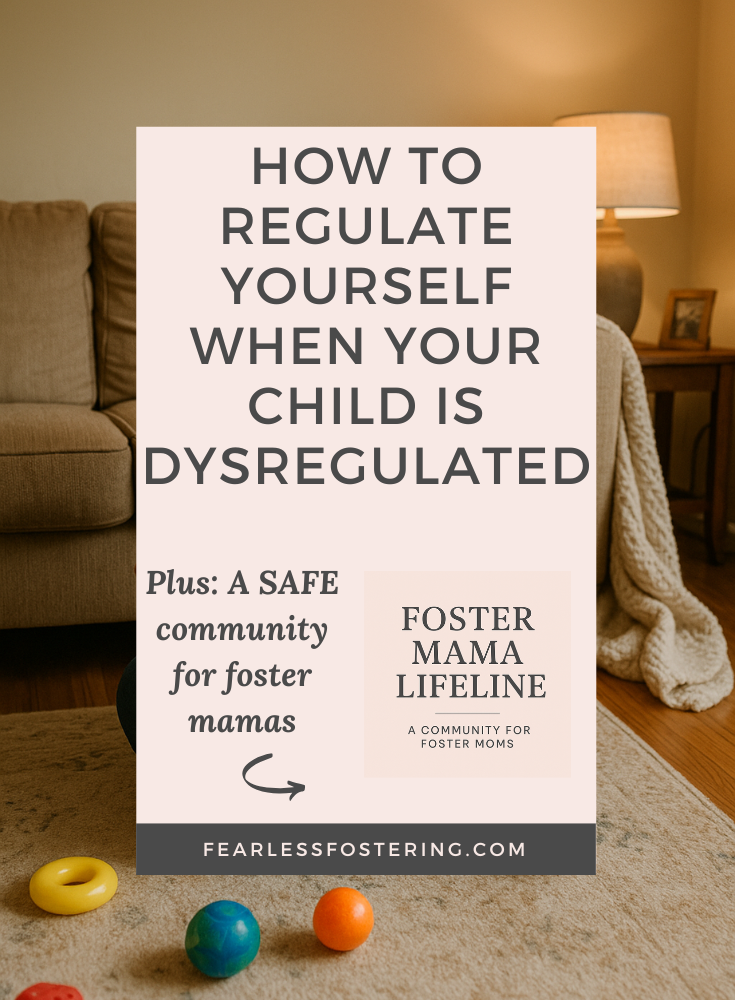
If you’ve ever stood face-to-face with a child in full-blown meltdown mode—screaming, hitting, crying, or shutting down—you know the pressure.
Your heart races. Your brain scrambles for the “right” response.
And suddenly, you’re the one feeling completely dysregulated.
This is one of the hardest truths about parenting—especially in foster care:
You can’t support a dysregulated child unless you know how to regulate yourself.
And that’s not easy when the moment feels personal, chaotic, or just plain exhausting.
Let’s break it down:
-
What regulation actually is (and what it’s not)
-
Why foster parents are more prone to dysregulation
-
Real strategies you can use in the moment
-
What to say when you freeze
-
And how to recover when it doesn’t go well (because sometimes, it won’t)
What Is “Regulation,” Really?
In short, self-regulation is your ability to notice your emotional state and bring yourself back to calm—without reacting impulsively or making things worse.
It doesn’t mean:
-
You’re calm 100% of the time
-
You never get triggered
-
You always respond perfectly
It does mean:
-
You can pause before reacting
-
You can recognize your internal cues (like a racing heart, shallow breath, or clenched jaw)
-
You’re able to model emotional safety for the child in front of you
Why This Is So Hard for Foster Parents
Let’s just say it: foster parenting is not average parenting.
You’re not just managing bedtime routines or homework battles. You’re parenting children with trauma histories, attachment wounds, sensory sensitivities, and survival behaviors.
On top of that, you’re navigating:
-
Caseworkers
-
Court systems
-
Bio family relationships
-
A lack of consistent support
-
And your own emotional responses to all of it
That’s a lot for anyone.
So when your child starts yelling, or throws something across the room, or shuts down for the fifth time that day—it makes total sense that you might lose it too.
But here’s the thing:
Your regulation is the anchor in their chaos.
You are the co-regulator. The calm in their storm.
Even when it doesn’t feel fair. Even when it’s hard.
5 Regulation Tools to Use in the Moment
Here are five trauma-informed strategies I teach (and use!) when things feel intense:
1. Pause + Breathe
Sounds simple, right? But when we’re triggered, we often stop breathing deeply without realizing it. Taking one intentional breath is a reset. Two is a choice. Three is a change.
🧠 Try this:
Inhale for 4 seconds, hold for 2, exhale for 6 seconds. Repeat 3x. Do it before you speak.
2. Narrate What’s Happening (Without Judgment)
Instead of reacting with frustration (“You’re being so rude!”), try narrating the moment calmly:
🗣️ “I can see you’re feeling really big right now.”
🗣️ “Your body is moving fast, and I want to help you feel safe.”
🗣️ “Let’s both take a second to breathe.”
This creates emotional safety without escalating tension.
3. Use Grounding Phrases—for You
Sometimes, it’s not about what you say to the child. It’s about what you say to yourself.
Here are a few I use:
-
“This is a hard moment. I can handle hard moments.”
-
“It’s not personal. It’s a trauma response.”
-
“I can be the calm one, even when it’s loud.”
If you’ve ever frozen in the moment and didn’t know what to say, that’s exactly why I created the First 5 Scripts Freebie—you’ll find trauma-informed phrases for when your brain goes blank.
4. Get Low + Get Soft
Kneeling down and lowering your voice sends the message:
“I’m not a threat. I’m here to help.”
When everything in your nervous system wants to get loud and big, this is how you flip the script. You signal to their brain: it’s safe now.
5. Take Space (When Needed)
If you feel yourself rising with anger, anxiety, or panic—you’re allowed to take a break.
You can say:
🗣️ “I’m feeling overwhelmed and I want to handle this well. I need a minute.”
🗣️ “I’m going to take a breath and come back calm.”
Stepping away before you explode is one of the most regulated things you can do.
When It Doesn’t Go Well (Because It Happens)
Let’s be honest: sometimes, you’ll yell.
Sometimes, you’ll cry after they go to bed.
Sometimes, you’ll say something you regret.
Here’s what matters more than perfection: repair.
Go back to them later and say:
🗣️ “I’m sorry I raised my voice earlier. That wasn’t your fault, and I’m working on staying calm even when things feel hard.”
This kind of repair builds trust. It shows your child what accountability looks like. And it teaches them that even when rupture happens, reconnection is possible.
Final Thoughts
Regulation isn’t something you master once and then check off the list.
It’s a daily practice—a relationship you build with your own nervous system.
But it’s also your greatest tool.
Because when you can regulate yourself, you change the dynamic.
You de-escalate.
You lead with safety.
You become the steady presence your child’s brain is desperately scanning for.
You don’t have to be perfect.
You just have to keep showing up—with a little more self-awareness, a little more breath, and a lot of grace.
Ready to Take This Work Further?
If you want weekly encouragement, practical tools, and real-life support from someone who gets it…
👉 Join me inside the Foster Mama Lifeline.
You’ll get access to gentle guidance, trauma-informed resources, and a community of foster and adoptive moms who are in it with you.
You don’t have to figure this out alone.
And you were never meant to.
+ show Comments
- Hide Comments
add a comment